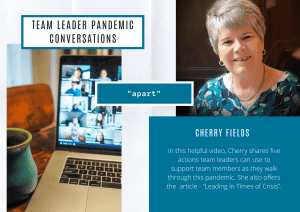Well, it’s been quite a ride over the past few weeks. From historical wellbeing pioneers to hot-off-the-press research. From the apologetics of why we should focus on wellbeing, to the employment legislation that requires it. From chocolate to blackberries (the phones).
For the reflective ones of you, I hope you’ve enjoyed the ride. For the more action-orientated, don’t worry. Today’s your day. We’re going to get practical.
There are so many books that could be (and have been) written on wellbeing within organisations, but today I want to simply outline six pointers for you to consider in moving this agenda forward in the movements you are part of. Here goes:
- Build the case. This has been a big focus of the articles in previous weeks and even back to the article I wrote 3 years ago on the strategic value of wellbeing. If your fellow leaders are still under the impression that wellbeing is optional, a ‘nice to have’ if it doesn’t get in the way too much, then this is your starting point. Use my stuff, do your research, gather the stories, but however you do it, build and present the case to leaders for why staff wellbeing needs to be at the heart of who we are and what we do.
- Know the warning signs. This is where you may need to figure out the presenting issues in your context. It’s work, but gaining expertise here can add real value to your movement. Culturally, the issues will vary, and the demographics of your staff team will also play a part in determining priorities. However, across all the areas of life that wellbeing touches (physical, mental, social, developmental, and financial), mental health is reported as the number one concern for employers globally. The UK’s Great Place to Work report revealed that the not-for-profit sector tended to score high in Relationships and Psychological safety at work but not so well in the more structural aspects of Mental, Physical, and (maybe inevitably) Financial health. Do you know what the significant factors would be in your context? Could you identify your strengths and weaknesses?
- Train your team leaders. As we talk about in our Member Care Framework, the local leaders are on the frontlines of staff care and wellbeing. How can we better equip them for this increasingly complex responsibility? For many countries, there will be legal implications. Much of the equality legislation in Europe places a duty on organisations to make “reasonable adjustments” for disabilities. Increasingly, the boundaries between what is and isn’t a “disability” when it comes to mental health are tricky to determine. This means there are some weighty issues our local leaders have to deal with, such as thinking about working patterns, physical environments, and staffing issues with their team members.
- Encourage self-care. Training leaders is important, but continuing to develop a culture of staff taking responsibility for their own care is vital. Helping them build their resilience and become aware of their boundaries. The UK mental health charity “Mind” has developed a superb “Wellness Action Plan” to help staff articulate their own needs. If you’ve coped with my articles these past weeks, you’ll probably be OK wading through all the extra vowels of British English (or ENGLISH English, as we prefer to say) to find the gems in their guide. You may not want to use the plan as written, but the principles and many of the questions at the end are great.
- Develop the Resource Network. There’s a whole host of stuff out there, and people that are committed to the wellbeing of staff in mission organisations. As a starting point, there are some resource lists in Session 5 of the LDHR Member Care course, and for those of you who are part of the CCCI family, the Global LDHR Workplace group is a great place to ask for and find resources in this area. Outside of our movement, various agencies collaborate to form networks, like the Member Care Europe Network. Wherever you are, you are not alone in this task. If it feels like you are, get in touch with the LDHR Llama (llama@cru.org), and he’ll introduce you to some of his friends.
- Make it a Habit, not an Event. Are you a project person? I’m realising more and more that I am. Whether it’s writing a series of Wellbeing and Retention articles or trying to get back to a healthy weight after Christmas bingeing, if it’s not a project, I struggle with the discipline of it. Too often, I recognise I make this mistake in leadership. Things that should be about cultural architecture become things to focus on for a while… and then move on to something new. If you’re like me, you might need a little help with this. What do you need to change that isn’t an initiative but something that becomes part of an annual (or monthly, or daily) rhythm? Surveys and needs assessments? Touch-points with leaders to find out how they and their teams are doing? Budget allocations? Communication pieces? You know your situation and people far better than I ever could, so you probably already have a good idea about what needs to become more a part of staff life.
This brings us all the way back to where we started: Now that you’ve built your case with senior leaders, it’s time to discuss how wellbeing and a culture of thriving in ministry can increasingly be the usual experience of staff and something that people talk about. A place where staff increasingly feel known, needed, and have a future. A great place to work, a place they’d hate to leave, and a place where staff want to recruit others to come and join in the fun.
LDHR leaders often have the trickiest and most complex of roles, but I’m so grateful for you and the investment you make in the lives of those serving the Gospel. I’ll certainly be praying for you this week as you figure out what’s next. Thanks for reading.










4 thoughts on “Putting it All Together (Wellbeing and Retention 6)”
Thanks Paul. That was an excellent and very practical way of ending this series. I have been sharing each article with my teammates. I am hopeful that we can make some positive steps forward together!
Blessings,
Sarah Overmyer
I’m so pleased you’ve found them useful, Sarah! Thanks for sharing them. Praying for you and your team as you lean into this.
Thank you Paul!! Several things in this article have been coming up during a stage 3 East Asia NT LWI coaching time while they are working on their SPP. I am so happy to pass this on to them! Super appreciate your ministry brother!
That’s so encouraging! Thanks so much for letting me know – it’s made my day!